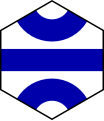Serpentiles
Serpentiles is the name coined by Kurt N. Van Ness for the hexagonal tiles used in various edge-matching puzzle abstract strategy games, such as Psyche-Paths, Kaliko, and Tantrix.[1] For each tile, one to three colors are used to draw paths linking the six sides together in various configurations. Each side is connected to another side by a specific path route and color. Gameplay generally proceeds so that players take turns laying down tiles. During each turn, a tile is laid adjacent to existing tiles so that colored paths are contiguous across tile edges.
Tile notation
Van Ness also coined a three-digit notation for tile categories, based on the paths shown on the tiles. The notation xyz refers to:[2]
- x = number of paths linking sides with adjacency 3, 2 segments apart (opposite sides)
- y = number of paths linking sides with adjacency 2, 1 segment apart
- z = number of paths linking sides with adjacency 1, 0 segments apart (adjacent sides)
It should be clear that adjacency 3 is the maximum. Van Ness also published a mathematical description: where is the count of segments with adjacency .[2]
-
003, indicating the paths link three adjacent sides
-
021, indicating the paths link one adjacent side and two sides one segment apart
-
102, indicating the paths link two adjacent sides and one set of opposite sides
-
120, indicating the paths link two sides one segment apart and one set of opposite sides
-
300, indicating the paths link the complete set of three opposite sides
Variations
| Name | Year | Path colors | Tile material | Tile count | Notes | ||
|---|---|---|---|---|---|---|---|
| Psyche-Paths | 1969 | 3 | Cardboard | 85 + 6 blank | |||
| Kaliko | early 1980s | 3 | Lucite | (clear) | 85 | Lucite pieces until 2001. Current printing uses bamboo/wooden tiles. | |
| Wood | |||||||
| Tantrix | 1988 | 4 | Plastic | 56 | Up to three colors appear on a single tile. Tiles are numbered on the reverse. Triple Cross tiles not used. | ||
Psyche-Paths
A game of Psyche-Paths requires one to six players. Players take turns laying down tiles. Each tile laid down next to tiles that have already been laid must continue the color of the path(s) on the existing adjacent edge(s). Six blank tiles are provided as "wild cards" and are considered to continue any adjacent path. One tile is drawn at the start of the game and placed in the middle of the playing field to "seed" the game.[3]
In "Beginner" Psyche-Paths, players draw one tile from a pool of face-down tiles when it is their turn. One point is awarded for each connected path. If the player is unable to play the tile or makes an illegal play, it is retained and the player is penalized a number of points equal to the number of paths running through the retained tile at the end of the game.[3]
In "Standard" Psyche-Paths, two to four players each draw a hand of six tiles at the start of the game. During each turn, players may play any or all of their tiles, replenishing to a hand of six tiles at the end of their turn from the pool of face-down tiles. When laying down tiles, points are awarded only when two or more ends of an existing path is connected. The player scores a number of points equal to the number of tiles containing the connected color path. Three points are awarded if the path crosses itself, and the score is doubled if the path is closed. No penalty is taken for leftover tiles.[3] "Classic" Psyche-Paths is similar to "Standard", but adds a rule that each move must result in a single path through all the tiles in that move.[3]
"Solitaire" Psyche-Paths does not have specific rules, but rather suggestions, such as building alternating rows of eight and nine pieces in length using legal moves.[3]
History
The original game, Psyche-Paths, was issued in the 1960s with the 85 unique tile combinations and 6 blank "wild cards" on cardboard tiles.[3] Steve Titus, a son of one of the inventors, reissued the game in the 1980s as Kaliko using screen-printed acrylic tiles under the family business Future Games. Kaliko was licensed to Kadon in 1986 with a switch to wood tiles after 2001.[4]
Tantrix was released in 1988 by inventor Mike McManaway using four of the five possible path combinations (using Van Ness's notation: 003, 021, 102, and 120, excluding 300) to create 56 unique tiles, each with three different colors chosen from a palette of four. The primary innovation of Tantrix is the encoding of numbers on the reverse side of the tiles, allowing subsets of the 56 to be used for solitary puzzles.[5]
Complete set of tiles
The complete set of 85 tiles, assuming a combination of up to three distinct path colors per tile, is shown in the table below, organized by notation and number of colors.
Tantrix uses the subset of tiles with three different path colors exclusively, and excludes the 300 Triple Cross series. With four possible path colors in Tantrix, there are four different color combinations with three different path colors, which gives 56 unique Tantrix tiles in a complete set:
- 003: 2 tiles with 3 path colors × 4 path color combinations = 8 Tantrix tiles in set 003
- 021: 6 tiles with 3 path colors × 4 path color combinations = 24 Tantrix tiles in set 021
- 102: 3 tiles with 3 path colors × 4 path color combinations = 12 Tantrix tiles in set 102
- 120: 3 tiles with 3 path colors × 4 path color combinations = 12 Tantrix tiles in set 120
References
- ^ Van Ness, Kurt N. "Serpentiles". van-ness.com. Retrieved 8 October 2017.
- ^ a b Van Ness, Kurt N. "Serpentile Descriptors". van-ness.com. Retrieved 8 October 2017.
- ^ a b c d e f "Psyche-Paths: Instructions". Funtastic, a Division of KMS Industries, Inc. 1969. Retrieved 8 October 2017.
- ^ "Kaliko: Larger image and brief history". Kadon Games. November 2003. Retrieved 8 October 2017.
- ^ Browne, Cameron (2015). "Game Design Patterns: Explore the Design Space". game & puzzle design. 1 (2). Raleigh, North Carolina: Lulu Press Inc: 75. ISSN 2376-5097. Retrieved 8 October 2017.
External links
- Scherphuis, Jaap (2015). "Jaap's Puzzle Page: Tantrix". jaapsch.net. Retrieved 8 October 2017.





















































































































































